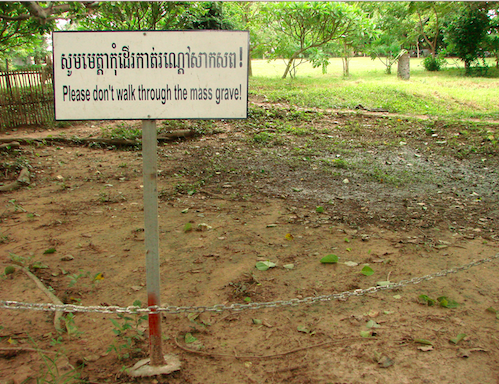Forgetting the Past in Siem Reap

Sign reads “Please don’t walk through the mass grave!” Source: Wikimedia Commons
Last semester, I published an article in this magazine entitled “The Urgent Importance of Teaching History.” In it, I argued that a solid education in history must be prioritized in order to encourage responsible citizenship. I pointed out that the foundation of our current political system was laid as a result of past historical events, and I argued the the modern tendency to forget those events has begun to weaken our global political order. Over December/January break, while I was visiting Siem Reap, Cambodia, I witnessed something that reminded me of what I wrote. Now, I’d like to share my experience with you.
* * *
Siem Reap is a city where history seems to come alive. Its livelihood depends on a steady stream of tourists who have come from around the world to tour Angkor Wat, a massive temple complex located nearby. The city is covered in depictions of beautiful Apsaras, goddesses that have been carved into the walls of Angkor by the thousands. Pyramidal towers, designed to emulate the Hindu god Shiva’s home in the Himalaya mountains, dominate the landscape. The walls of nearby Angkor Thom illustrate the history of the Khmer Empire—one filled with violent battles and great kings. It seems as if people come to Siem Reap to escape into the fanciful world of the Khmer Empire’s past.
Every so often, however, the walls of Angkor Wat tell the story of a very different, far more recent kind of war. Not only are they covered in intricate carvings that depict harrowing battles, but they are also pockmarked with bullet holes. The stores and streets of Siem Reap, while filled with local Cambodians who depend on the tourists for their income, are eerily devoid of the senior citizens who seem far more common elsewhere in Asia. Why? Because in the late 1970s, Cambodia bore witness to one of the most brutal genocides in modern history.
In 1975, the Prime Minister of Cambodia was overthrown by the Communist Party of Kampuchea, also known as the Khmer Rouge. Pol Pot, the leader of the Khmer Rouge, sought to turn Cambodia into an idealized “agrarian society” in which the entire population worked on collective farms, produced its own food, and was free of class distinctions. To achieve this aim, Pol Pot’s military forced the residents of the cities into the countryside, murdered anyone considered unfit for agricultural labor, massacred the country’s educated citizens, and slaughtered its ethnic minorities. In 1979, Vietnam invaded Cambodia to remove the Khmer Rouge and put an end to the atrocities. By then, between a quarter and a third of the country’s population had been killed or had starved to death.
As much as my family enjoyed learning about the centuries-old history of the Khmer Empire, we could not leave Cambodia without learning this more recent history of the Khmer Rouge. As a result, we decided to visit the Siem Reap War Museum. As our van pulled into the dusty parking lot, we saw the hulking outlines of rusted out tanks, a decommissioned helicopter, and a cold-war era Soviet fighter jet. We were met by a guide who, although too young to experience the brunt of the Khmer Rouge, told us stories about growing up in the immediate aftermath of the genocide that destroyed his country.
The museum, which was completely outdoors, contained a large grassy area in the center and covered exhibits along the edge. Our guide led us to the first few exhibits, one of which outlined the events leading up to the war and another the effect of landmines on the country. As I inspected photos of victims of landmines, many of whom had missing limbs or terrible burn scars, my focus was shattered by an irritating sound coming from the minigun sitting in the overgrown grass a few meters away.
“Pew, pew, pew,” I heard as I turned my head. Another tourist, a boy of about 12 years old with an accent that sounded Australian, was sitting in the seat of the minigun and imitating the sound of the bullets that had, not so many decades ago, been used to murder the people of this country. I could not take my eyes off of him as he moved on to the row of guns that lined the wall and ran his hand along it, completely enthralled. When he remarked, eyes wide, “Look! This one has a bayonet!” to his father, I cringed and silently wondered how many Cambodians had been impaled by the very piece of metal that he now held in his hands.
Eventually, my attention shifted away from the young Australian tourist and back to our guide. Now, he was telling a story from his childhood in Battambang, the last holdout of the Khmer Rouge. One day, he said, the government forces bombed his village in an attempt to rout Pol Pot’s bedraggled forces. The townsmen ran for cover, and a few minutes later their town lay in ruins. Even today, our guide said, his mother runs for cover when a commercial airliner flies overhead.
Today, Cambodia is a different country. Its population has skyrocketed, and the tourism industry is thriving. Nevertheless, as our guide’s mother reminded us, the scars of war remain. Another reminder is the country’s Prime Minister, Hun Sen. He has been the Prime Minister since the fall of the Khmer Rouge, even after the United Nations attempted to remove him from power in the 1990s as his popularity fell in the face of rising corruption and authoritarianism. Considering the country is due to hold elections next year, we asked our guide what he thought of the country’s political situation. He seemed to agree with the general sentiment that we’d heard before: a new Prime Minister would be better. He also added a new idea: but there’s nothing we can do about it.
The problem, of course, is that there is one thing, one terrible thing, that they could do about it. They could find the same excitement in guns as one particular 12-year-old Australian. But they never will as long as their people remain scarred by landmines and afraid of commercial airliners. Someday, however, they may forget. And when that day comes, Cambodia will become a more dangerous place. That is the paradox of war. After every war, speeches are made commemorating the dead, poems are written decrying the failure of humanity, and the people come together to vow “never again.” But there will always be an again if we forget the poems; if our eyes widen in admiration rather than fear at the sight of instruments of war.
* * *
If you could hear, at every jolt, the blood
Come gargling from the froth-corrupted lungs,
Bitter as the cud
Of vile, incurable sores on innocent tongues,—
My friend, you would not tell with such high zest
To children ardent for some desperate glory,
The old Lie: Dulce et decorum est
Pro patria mori.
–Wilfred Owen, 1920

Jack, a senior, is excited to begin his second year in The Talon and to work with Isabela as one of its two Editors-in-Chief. He is a fervent dog lover...









